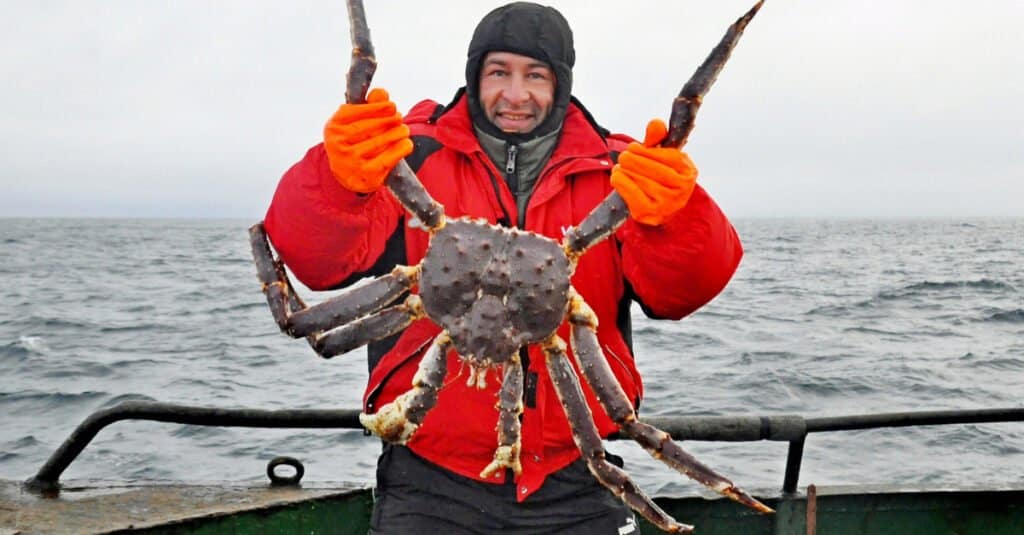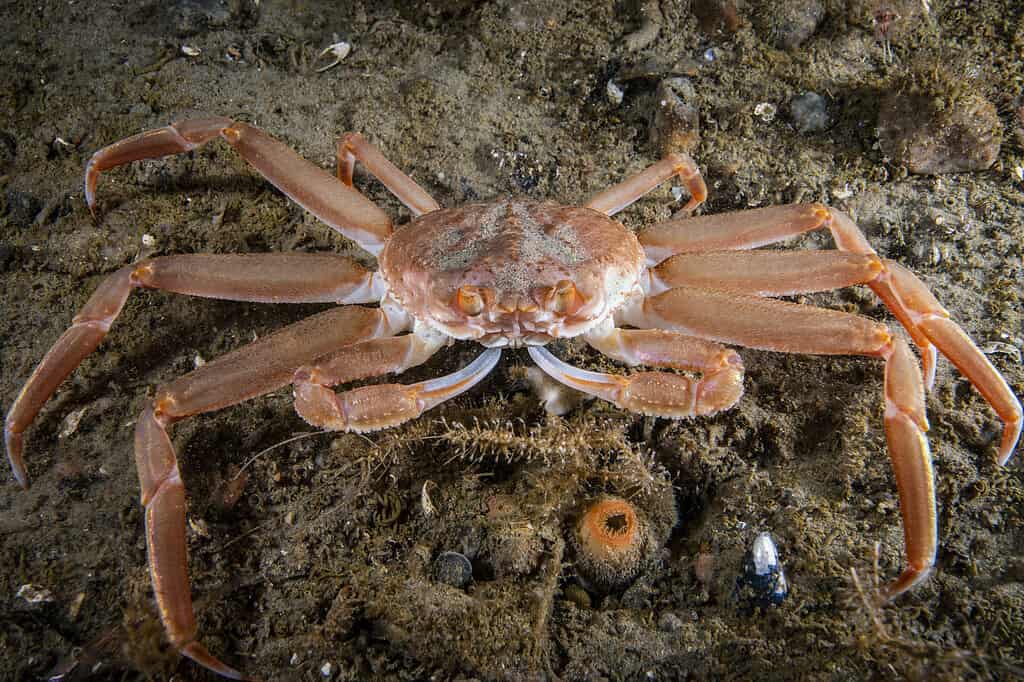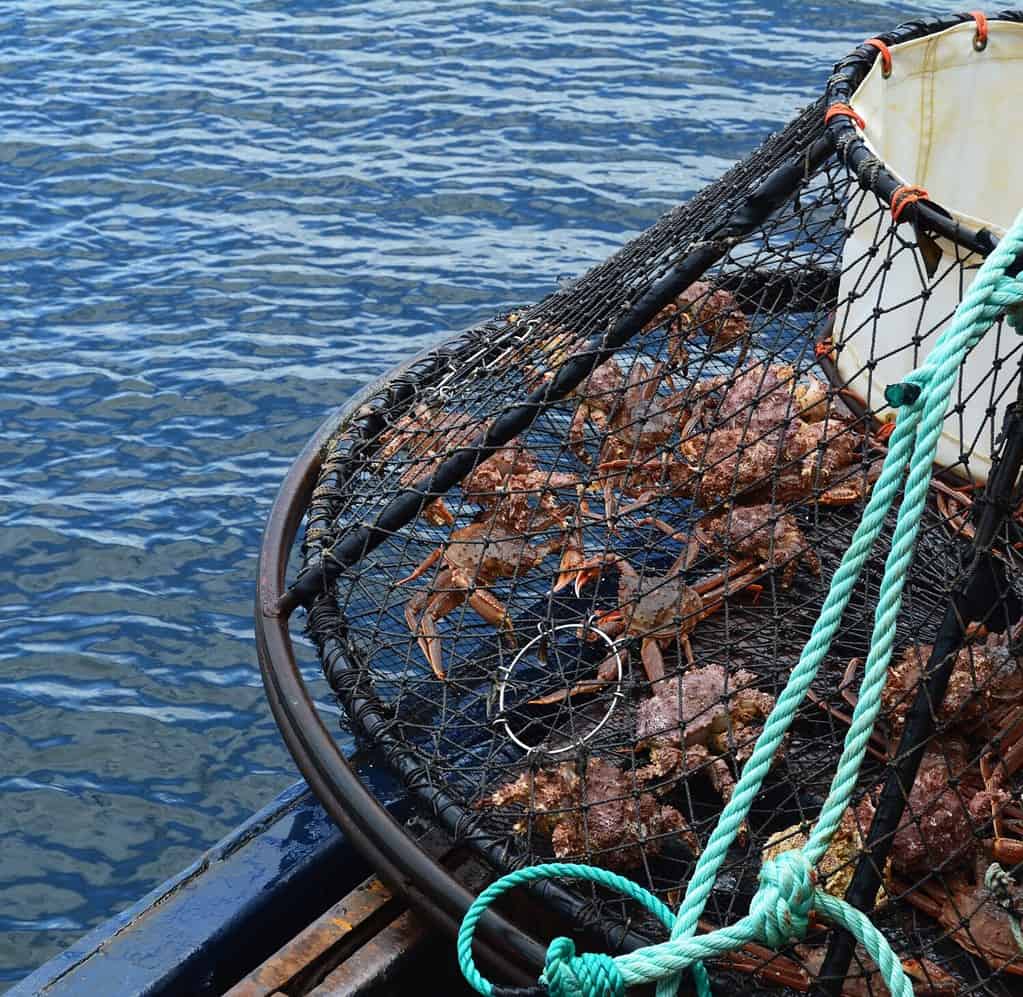
Alaska has some of the biggest crabs, like the Red King Crab.
©Don Serhio/Shutterstock.com
Alaska is infamous for its big, beautiful crabs. King crabs are many people’s favorites, but the average non-commercial fisherman fishes for Tanner or Dungeness crabs during the Alaska crabbing season. Let’s explore some of the regulations, rules, and limits you must follow to go crabbing in Alaska.
When is Crabbing Season in Alaska?

When you can harvest Alaskan crabs is determined by the species you are fishing for.
©iStock.com/LaSalle-Photo
The timing of crab season in Alaska depends on the breed of crab you are fishing for, where in Alaska you are fishing, and whether you are a commercial or non-commercial fisherman. Non-residents may not catch king crabs.
King crab season in Alaska occurs from October until January. The Alaska Department of Fish and Game has closed the crab season for blue and red king crabs in the past six years. Subsequently, the fish and game department conducted surveys to determine the number of king crabs. No fishermen can catch and keep king crabs when the numbers exceed the regulatory amount.
Tanner crab season is closed from June 16th until June 30th for all of Alaska except the area of Yakutat.
Dungeness crab season is closed all year in Yakutat.
Licenses to Crab in Alaska

A valid sport fishing license is required for fishing during the Alaskan crabbing season.
©Ashley-Belle Burns/Shutterstock.com
Before crabbing in Alaska, you must have a valid sport fishing license. Residents who are 60 years of age and possess the Alaska Department of Fish and Game pertinent identification card are exempt from purchasing a yearly shellfish license.
Residents who are 18 years of age or younger are exempt from license requirements. Accordingly, non-residents who are 16 years of age are also exempt from the shellfish license requirement.
License Costs for Alaska Residents
To meet the requirements of being a resident of Alaska, a person must have maintained a residence in the state for the last 12 months and intend to remain in the state indefinitely except for military personnel and their families.
Low-Income Residents
Alaska provides low-income families and individuals a reduced-cost fishing, hunting, and trapping license. Eligibility for these licenses is based on family size and annual income.
Let’s take a look at the low-income requirements:
| Members of the Household | Annual Salary for Household |
| 1 | $18, 210 |
| 2 | $24,640 |
| 3 | $31,070 |
| 4 | $37,500 |
| 5 | $43,930 |
| 6 | $50,360 |
| 7 | $56,790 |
| 8 | $63,200 |
- The Sport Fishing License costs $20 per year.
- A Sport Fishing, Hunting, and Trapping license for qualified low-income families costs $5.
- A sport fishing license for the blind costs $0.50.
License Costs Non-Resident
A non-resident is anyone who does not meet the Alaska Department of Fish and Game residency requirements. Non-resident licenses are valid from one day up to one year.
- One day: $15.00
- Three days: $30.00
- Seven Days: $45.00
- 14 Days: $75.00
- Annual: $100
Commercial Licenses and Charter Fishing

Fishing on a commercial fishing boat requires licenses and special permits.
©Gema Alvarez Fernandez/Shutterstock.com
Anyone aboard a commercial fishing boat must possess a valid fishing license issued by the Alaska Department of Fish and Game. These licenses are $60 for Alaskan residents and $200 for non-residents. Commercial boats must obtain permits for the species of crab they fish for. The permits are valid for specific amounts of time.
Bag Limits for Crab Season in Alaska

The daily bag limit of crabs allowed during the Alaska crabbing season changes according to species.
©Kairos_JC/Shutterstock.com
The bag limits and size limits vary according to the species of crab you are catching and the type of license you have. You may not have more than the daily bag limit in your possession. Alaska only allows male crabs to be kept. The male crabs have a narrow abdominal flap and grow larger than the minimum size limit. The female crabs have abdominal flaps that cover most of their underside.
Let’s take a look at the bag limits and requirements of the three main crabs in Alaska.
| Crab Species | Daily Bag Limit | Size Limits |
| King | Decided by Fish and Game | – |
| Tanner | 30 Male Only | 5 1/2″ Minimum |
| Dungeness | 20 Male Only | 6 1/2″ Minimum |
| Crab Species | Daily Bag Limit | Size Limits |
| King | 0 | – |
| Tanner | Three males in combination | 5 1/2″ Minimum |
| Dungeness | Three males in combination | Three males |
Equipment Approved for use During Crab Season in Alaska

Traps, pots, and dip nets are all approved equipment for use during the Alaska crabbing season.
©Vintagepix/Shutterstock.com
The pots and nets used during the Alaskan crabbing season must meet the detailed requirements with the correct number and size of escape rings according to the species of crab you are fishing for.
Escape Rings for Crabbing Pots
All pots require two escape rings. The escape rings are on opposite sides of the pot. The requirements according to species are:
| Crab Species | Escape Ring Size | Special Notes |
| King | 4⅜ inches inside diameter | None |
| Tanner | 4¾ inches inside diameter | None |
| Dungeness | 6¼ inches inside diameter | The escape rings must be on the upper half of the pot. |
The approved equipment for use in the Alaskan crabbing season includes:
- Rigid mesh pots with one rectangular hole in the sidewall.
- Non-rigid mesh pots with an opening that is 18″ long.
- Dip nets
- Hands
- Hands
- Hookless hand lines
- Hand lines with hooks
- Diving gear
The photo featured at the top of this post is © Don Serhio/Shutterstock.com
Thank you for reading! Have some feedback for us? Contact the AZ Animals editorial team.






